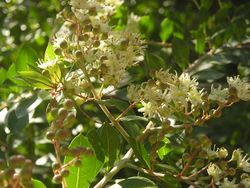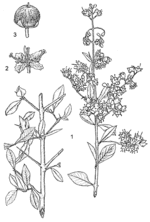Henna
| Henna |
|---|

|
| Scientific Classification |
|
| Binomial Name |
|
Lawsonia Inermis |
| The henna plant being grown from home |
Henna is a species of shrub known by the scientific name Lawsonia inermis. It is also known as hiram henna tree, mignonette tree, and Egyptian privet. It is perhaps best known for its use as a dye for clothing and body art. Henna is also helpful and used for medicinal purposes because of the components the leaves contain. The leaves of the Henna are harvested twice a year, once the flower appears. The leaves are dried, and then crushed into a powder. This powder is mixed in with acidic liquid, such as lemon juice, and then the henna paste is created.
Anatomy
Henna is a small tree and is a very branched glabrous shrub, and may be spiny. It is able to grow from 6 to 25 feet (1.8 to 7.6 m) tall. On opposite sides of the stem, small, lance-shaped leaves grow.[2] The young branches are green but with age turn red. The veins on the upper surface are depressed. They have many small, white flowers. There are 4 petals squeezed together in the bud. The fruits are small and brown and have capsules that are 4-8mm in diameter. The plant has many seeds, and they open spontaneously. The seed inside the fruit is 3 mm in diameter and has a thick seed coat.[3]
Ecology
Henna is a tropical shrub native to southern and western Asia, Australia, and North Africa. It is also grown in Florida and California as an ornamental plant.[2] For growth, development, and germination, henna requires high temperatures (optimum daily average about 25°C). Henna is able to grow in poor, stony, and sandy soils, but it can also adapt to heavy, fertile clay soils. It can tolerate low air humidity and drought.[4]
Henna is native to Iran and western India. The plant was spread eastward to eastern India and Indonesia, and then westward to the Middle East. From those locations it is then spread across the world. Henna is most often grown from home gardens. Commercial gardening is limited to a few areas of India, Pakistan, Egypt, Libya, and Sudan.[5]
The growth of Henna is better in tropical savannah and tropical arid zones, with a latitude between 15 degrees and 25 degrees (north and south). Henna produces its most abundant dye content in temperatures between 35 to 45°C. For germination the optimal soil temperature range is 25-30°C.[6]
Traditional Use
Also called mehndi in Hindi and Urdu, henna has been used for approximately 5000 years in Pakistan, India, Africa, and the Middle East. People in the desert have been taking advantage of henna's natural cooling properties for centuries. People with the resource would make a paste and soak their palms and soles of their feet in the paste to start a air conditioning affect. The cooling sensation would stay throughout their body as long as the henna stain remained. When the people saw the henna fade away, they realized it would leave a pattern on their skin, which led to the idea of using henna for decorative purposes. Mummies during ancient Egyptian times, would wear henna designs. This adornment was not only used by those who were rich, but was also used by the poor who could not afford jewelry.[7]
Henna is useful in many ways, such as self-expression, celebration of a special occasions, cosmetic treatments, medicinal uses, being a part of an ancient tradition, or as an alternative or precursor to a tattoo. Henna leaves are a popular dye for hands, fingers, nails and hair. The dye molecule, lawsone, is the important constituent of the plant; the highest concentration is located in the petioles.[6]
Henna is traditionally used for special occasion such as birthdays and weddings in Africa, Pakistan, India, and the Middle East. A popular event is called the Mehndi Night. This night is where the bride, her family, and friends join together and celebrate the wedding that is soon to come. The night is full of music, dance performances, and games. The bride gets extensive henna designs done on her feet and hands and sometimes her elbows and knees. These patterns take hours and may be done by various henna artists. Wedding guests will usually receive a small henna design on the backs of their hands.[7]
Henna is used for manufacturing cosmetics, hair dyes, and hair care products. Henna is also used for dying nails, hands, and clothing. [8]
In recent times, henna began to make its way toward the west. Now people all over the world have adopted the tradition of decorating their bodies with the natural artwork that is created from the henna plant. People decorate their hands and feet for weddings, or stomachs while pregnant. Heads are decorated while the person goes through chemotherapy, and scars are camouflaged to make then not noticeable.[7]
Henna has also been used as an anti-hemerrhagic, astringent, intestinal antineoplastic, cardio-inhibitory, hypotensive, therapeutic against amoebiasis, headache, jaundice, and leprosy.[6] It has historically been used for severe diarrhea that is caused by a parasite (amoebic dysentery), cancer, enlarged spleen, and skin conditions. Today, there are people that will take henna for stomach and intestinal ulcers. Henna is used topically for dandruff, eczema, scabies, fungal infections, and wounds.[8]
Video
References
- ↑ Classification United States Department of Agriculture. Web. Accessed 14 May 2015. Unknown Author.
- ↑ 2.0 2.1 Henna How Stuff Works. Web. Published 21 October 2008. Unknown Author.
- ↑ Database, Agroforestry. Lawsonia inermis. BOTANIC DESCRIPTION. World Agroforestry. Web. Published 2009.
- ↑ Aweke, G. Lekoyiet, Tapapul, Suzanne. Ecology Prota4u. Web. Published 2005.
- ↑ Lawsonia Inermis Globinmed. Web. Accessed 26 May 2015.
- ↑ 6.0 6.1 6.2 Makhija, Kumar, Inder. Lawsonia Inermis-From traditional use to scientific assessment 'Pharmatutor'. Web. Published 2009.
- ↑ 7.0 7.1 7.2 About Henna Silk and Stone. Web. Accessed 26 May 2015. Unknown Author.
- ↑ 8.0 8.1 Henna WebMD. Web. accessed 26 May 2015. Unknown Author.



